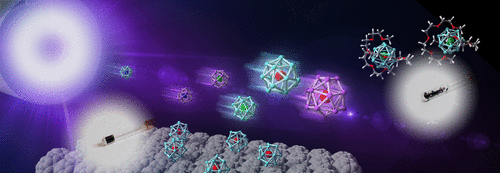当前位置:
X-MOL 学术
›
Acc. Chem. Res.
›
论文详情
Our official English website, www.x-mol.net, welcomes your
feedback! (Note: you will need to create a separate account there.)
Synthesis and Characterization of Metal-Encapsulating Si16 Cage Superatoms
Accounts of Chemical Research ( IF 16.4 ) Pub Date : 2018-05-01 00:00:00 , DOI: 10.1021/acs.accounts.8b00085 Hironori Tsunoyama 1 , Masahiro Shibuta 2 , Masato Nakaya 3 , Toyoaki Eguchi 4 , Atsushi Nakajima 1, 2
Accounts of Chemical Research ( IF 16.4 ) Pub Date : 2018-05-01 00:00:00 , DOI: 10.1021/acs.accounts.8b00085 Hironori Tsunoyama 1 , Masahiro Shibuta 2 , Masato Nakaya 3 , Toyoaki Eguchi 4 , Atsushi Nakajima 1, 2
Affiliation

|
Nanoclusters, aggregates of several to hundreds of atoms, have been one of the central issues of nanomaterials sciences owing to their unique structures and properties, which could be found neither in nanoparticles with several nanometer diameters nor in organometallic complexes. Along with the chemical nature of each element, properties of nanoclusters change dramatically with size parameters, making nanoclusters strong potential candidates for future tailor-made materials; these nanoclusters are expected to have attractive properties such as redox activity, catalysis, and magnetism. Alloying of nanoclusters additionally gives designer functionality by fine control of their electronic structures in addition to size parameters. Among binary nanoclusters, binary cage superatoms (BCSs) composed of transition metal (M) encapsulating silicon cages, [email protected]16, have unique cage structures of 16 silicon atoms, which have not been found in elemental silicon nanoclusters, organosilicon compounds, and silicon based clathrates. The unique composition of these BCSs originates from the simultaneous satisfaction of geometric and electronic shell-closings in terms of cage geometry and valence electron filling, where a total of 68 valence electrons occupy the superatomic orbitals of (1S)2(1P)6(1D)10(1F)14(2S)2(1G)18(2P)6(2D)10 for M = group 4 elements in neutral ground state. The most important issue for [email protected]16 BCSs is fine-tuning of their characters by replacement of the central metal atoms, M, based on one-by-one adjustment of valence electron counts in the same structure framework of Si16 cage; the replacement of M yields a series of [email protected]16 BCSs, based on their superatomic characteristics. So far, despite these unique features probed in the gas-phase molecular beam and predicted by quantum chemical calculations, [email protected]16 have not yet been isolated.
更新日期:2018-05-01











































 京公网安备 11010802027423号
京公网安备 11010802027423号